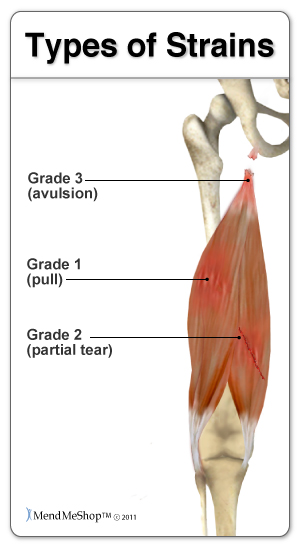|
| Symptoms of a Pulled HamstringDecreased FlexibilityYou may experience stiffness or decreased range of motion (ROM) as a result of a pulled hamstring muscle. The tightness at the back of your thigh will make it difficult to flex your knee or straighten your leg. Your gait may be affected, or you may limp when you walk if the stiffness causes discomfort. Muscle spasm may also occur in the injured hamstring. Injury can make the muscle and/or nerves behave abnormally and improper contraction signals may be sent to the brain causing the muscle to spasm. Swelling and BruisingSwelling in your hamstring muscles is a result of your tissues becoming inflamed; this normally occurs with a more serious hamstring strain. Warmth and redness may accompany swelling in severe cases. You may also feel a gap, dent or bulge in your muscle that is not normally present. Occasionally, bruising (hamstring contusion) and discoloration over your hamstring muscle may appear immediately or after a few days with severe hamstring strains. Weakness Weakness or complete loss of function of your hamstring muscle can also be experienced as a result of a pulled hamstring. This along with your other symptoms may make it difficult for you to walk or run and can result in you walking with a limp. With an avulsion, or rupture, you will experience difficulties walking without assistance, a cane, or crutches. You could even feel a gap in your muscle with a complete tear. Popping NoiseA popping or snapping sensation at the back of your thigh can often be heard and felt when your hamstring muscles are tearing. This often happens with a large force of hip flexion when your knee is extended (straightened) and may cause you to fall to the ground. Degree of InjuryThere are varying degrees of pulled hamstring muscles. The strain is classified by how severe the damage to the hamstring is. Mild Hamstring PullThis is also known as a 'Grade I' tear. A mild strain is classified as the overstretching of the fibers of the muscle or tendon. This type of strain causes discomfort in the upper thigh (and possibly lower back) area as opposed to acute pain. A mild muscle strain can be treated with a Cold Compress or Ice Pack cold compression wrap and Circulation Boost (via the TShellz Wrap®) to improve the health of the muscle tissue and restore the elasticity to reduce the risk of re-straining or tearing.  Hamstring TearThis is also known as a 'Grade II' tear and is an actual tearing of the fibers in the muscle and/or tendon. It would feel like a sharp pain in the back of the leg and you may hear a tearing sound at the time of the injury. There will be a visible hamstring contusion, or bruising, in the torn muscle area in the days following the injury. This grade of strain can also be effectively treated with cold compression Circulation Boost. It is recommended that you allow your hamstring and other leg muscles to rest when you can to allow the tear to heal. Hamstring RuptureThis is also known as a 'Grade III' tear. When a muscle ruptures, or tears completely, you will feel a very sharp pain at the point of the tear and you may hear or feel a 'pop'. If you have a multi-muscle tear, it normally occurs at the point where your hamstring tendons and muscles meet near the ischium. There will be a significant amount of pain when attempting to move the leg and your range of motion will be limited. There will be a noticeable contusion (hamstring bruising) and swelling. Treatment of a complete tear usually requires surgery to re-join the muscle tissue at the point of the tear. Product specialists are available 9:00 am to 5:00 pm Eastern Standard Time Monday to Friday. If any question or concern arises, call us or simply send us an email at any time (we check our emails constantly all throughout the day and night.. even on holidays!). We will respond as soon as possible. North America Toll Free 1-866-237-9608 |
    |